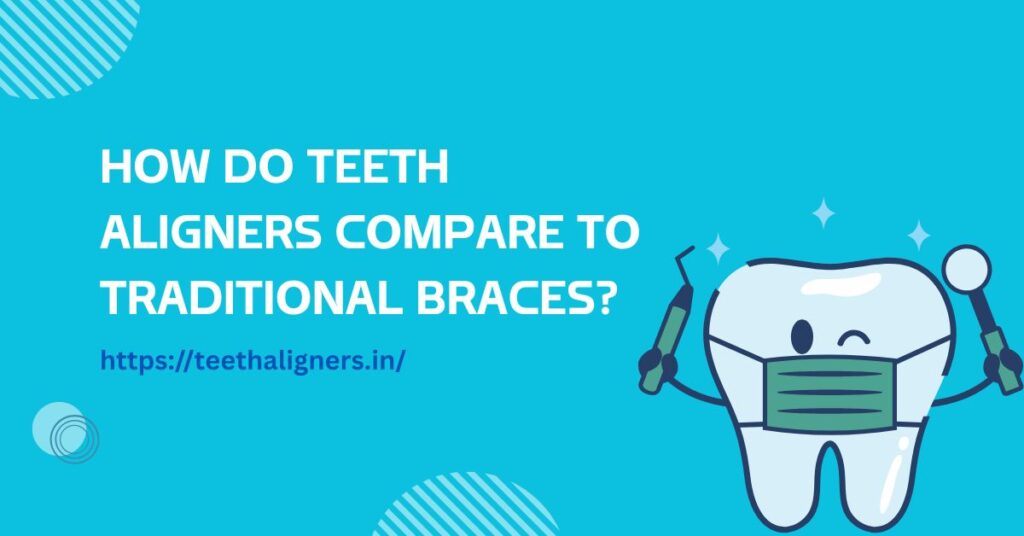Many people dream of having a straight, confident smile. But when it comes to choosing how to achieve that smile, the options can feel overwhelming. Two of the most popular treatments are traditional braces and clear aligners.
Both are designed to move your teeth into better positions, but they work in different ways and offer different experiences.
This article will explain how these two methods compare, so you can make the best choice for your needs.
Table of Contents
ToggleWhat Are Traditional Braces?
How Traditional Braces Work
Traditional braces have been used for decades to correct crooked teeth, gaps, and bite problems.
They use small metal brackets that are glued to the teeth. A thin wire connects the brackets and applies gentle pressure to move the teeth over time.
Your orthodontist adjusts the wire every few weeks to keep the movement going. This process gradually shifts your teeth into better alignment.
While braces are effective, many people today are also considering Teeth Straightening Aligners as a modern alternative.
These clear trays offer a more discreet and flexible option for those who want to straighten their teeth without metal brackets.
Common Experience With Braces
Most people wear braces for 18 to 36 months, depending on how complex their dental issues are. During that time, you’ll have regular appointments for tightening and checking your progress.
One downside is the food restrictions—chewy, sticky, or hard foods can damage the wires or get stuck in the brackets.
Cleaning your teeth also becomes harder, as food can easily get trapped, and special brushes are often needed.
Because metal braces are fixed to your teeth, they are clearly visible when you smile or speak.
What Are Teeth Aligners?
How Aligners Work
Teeth Aligners are made from clear plastic and are custom-shaped to fit over your teeth. Instead of using wires and brackets, they work by applying light pressure through a series of trays.
Each tray is worn for about one to two weeks before switching to the next one in the series. Over time, these trays slowly move your teeth into the desired position.
What Makes Aligners Different?
One of the biggest differences is that aligners are removable. You can take them out when you eat, drink (anything other than water), or brush your teeth.
This gives you more freedom in your daily routine. They’re also nearly invisible, which makes them a popular choice for people who prefer a more discreet treatment.
Because they’re designed using digital scans or impressions, the fit is very precise. Another benefit is that aligners often require fewer dental visits compared to braces.
Comparing Comfort and Convenience
Daily Life with Braces vs Aligners
Living with braces often means adjusting to some level of discomfort. The brackets can irritate the inside of your cheeks or lips, and after each adjustment, your teeth may feel sore.
On the other hand, aligners are made from smooth plastic and fit closely around your teeth, which makes them more comfortable for most people. You won’t have metal parts poking your mouth or the need for wax to prevent irritation.
Eating and Oral Hygiene

Braces can make eating a challenge. Some foods get stuck easily, and you need to be extra careful when brushing and flossing.
It takes more time and effort to keep your mouth clean. With aligners, you remove them before meals, so there are no food restrictions.
After eating, you simply brush your teeth and clean the aligners before putting them back in. This makes maintaining good oral hygiene much easier.
Appearance and Confidence
Visibility Matters to Many
For many people, especially teenagers and working adults, appearance plays a big role in choosing an orthodontic treatment.
Braces are made of metal and are very noticeable, even from a distance. Some people don’t mind this, but others may feel self-conscious about how they look.
That’s where Teeth Aligners have a clear advantage—they are hard to spot when worn. They allow people to straighten their teeth without drawing attention to their treatment.
Public and Social Comfort
If you work in a public-facing job or attend frequent social events, aligners can help you feel more confident.
Since they are clear and removable, you don’t have to worry about how your smile looks in photos or while speaking in meetings.
Many adults in India now choose aligners because they offer a more modern and less noticeable solution.
Treatment Time and Results
Speed of Correction
When it comes to results, both methods are effective, but the timeline can vary. Traditional braces may be more suitable for complex dental problems, including severe bite issues and major tooth rotations.
Aligners often work faster for simple to moderate cases. If the patient wears them as directed, they can see visible changes in a few months.
The key difference lies in how each approach handles different levels of dental correction.
Following the Plan Matters
Aligners must be worn 20 to 22 hours a day to be effective. This means you need to be disciplined and consistent.
If you forget to put them back in after meals or skip wearing them for long periods, your treatment may take longer.
Braces don’t have this problem—they’re always working because they’re fixed in place. That’s why braces are often recommended for younger children who might forget or lose removable trays.
Maintenance and Cleaning
Taking Care of Braces
Maintaining oral hygiene with braces takes extra care. You need to brush around the wires and brackets carefully. Special brushes and floss threaders are often required to reach between your teeth.
If you’re not careful, food particles and plaque can build up around the brackets, increasing the risk of cavities and gum issues.
Cleaning Aligners
With aligners, the cleaning process is simpler. You rinse them with lukewarm water and use a soft toothbrush to clean them gently. It’s important not to use hot water, as it can warp the plastic.
Some people use cleaning tablets once or twice a week for a deeper clean. When not in use, aligners should always be stored in a clean case to keep them safe and hygienic.
Costs and Availability in India
Price Range for Both Options
Braces and aligners can both be costly, and the total price often depends on how long the treatment takes and how complex your dental issues are.
Generally, metal braces might be slightly more affordable, but aligners offer benefits that many people find worth the extra cost. This includes comfort, appearance, and fewer trips to the clinic.
What People Choose in India
In India, there’s been a noticeable shift toward clear aligners. This is especially true among young professionals and students who want a more flexible and modern treatment option.
Clinics like Teeth Aligners in India are making it easier to access clear aligners with new technology and services such as online consultations and remote progress monitoring.
These features are helping more people start treatment without needing to visit the clinic often.
Which Option Is Right for You?
Choose Based on Your Needs
Choosing between braces and aligners depends on your specific dental situation and your lifestyle.
If your case is complex or you have major bite issues, traditional braces might be the better choice. They provide constant correction and don’t rely on you remembering to wear them.
However, if your dental issues are simpler and you prefer something less visible and more convenient, Teeth Aligners could be the perfect solution. They fit well into busy lives and allow more control over your daily routine.
Always Consult a Professional
Before making any decision about straightening your teeth, it’s essential to consult with a qualified dentist or orthodontist in India.
A professional will start by examining your mouth thoroughly, checking the alignment of your teeth and bite.
They may use digital scans, photographs, or X-rays to get a detailed view of your dental structure.
This allows them to understand the current condition of your teeth and how much movement is needed to achieve your desired results.
During your consultation, you’ll also have the opportunity to talk about your personal goals—whether that’s closing gaps, correcting bite issues, or simply wanting a straighter, more confident smile.
Your dentist will explain the pros and cons of available treatment options, such as braces or clear aligners, and help you understand which approach suits your lifestyle, comfort level, and budget.
Getting expert guidance early in the process helps you avoid unnecessary complications, wasted time, or ineffective results.
With the right plan, you’re more likely to stay on track and reach the smile you’ve always wanted—safely, efficiently, and with confidence.
Conclusion
Braces and aligners both help straighten your teeth, but the way they work and feel is different. Braces stay on your teeth and are great for fixing tough problems.
Aligners give you more freedom and are less noticeable. When making a choice, think about your daily habits, how much effort you’re willing to put in, and how important appearance is to you.
No matter which option you pick, you’re making a smart move toward better oral health and a more confident smile—with trusted options like Teeth Aligners in India guiding your journey.

